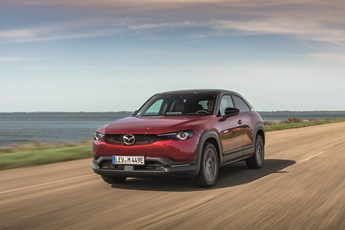
The start point for the best source of fleet information |
First drive: Mazda MX-30
Date: 21 October 2020 | Author: Pete Tullin

|
|
||||||||||||||||
Nothing is for nothing in this life and the more we learn about electric vehicles the more we realise they aren't quite the silver bullet we were promised.
Sure, the current low BIK tax rated for electric cars is a hugely persuasive inducement and the positive effects zero tailpipe emissions have on local air quality cannot be underestimated.
That doesn't mean there aren't worrying clouds on the horizon for electric vehicle production, not least the vast clouds of CO2 emissions that are a by-product of the battery production process.
With this thorny problem in mind, Mazda reckons smaller batteries such as the one fitted to its all-new MX-30 electric SUV are a more planet-friendly solution, which brings us neatly back to the nowt-for-nowt conundrum. Smaller batteries may be less CO2-intensive to produce but they also generate less power and require more frequent charging.
The MX-30's 35.5kWh battery is capable of just 124 miles between charges - a range that will no doubt be reduced considerably in freezing winter conditions. That's not what you want if you've just finished a dreary Friday afternoon meeting in Birmingham and face the prospect of a tedious mid-journey charge-stop on your way back to the Home Counties.
More positively, at approximately 30 minutes to reinvigorate the MX's powerplant from a service station fast charger, providing you can find an unoccupied one, you should be on your way quicker than it takes to scoff a Ginsters and quaff a cup of brown stuff. Once home, charging from a 7kW wall box takes approximately five hours.
The MX-30's electric motor is not exactly pushing the boundaries of nuclear fusion, generating a modest 145hp. Tasked with tugging around 1,645kg of metalwork and batteries, which, to be fair, is light by electric car standards, the motor will motivate the MX-30 to 62mph in just under 10 seconds.
Not that compact SUVs live or die by performance coefficients, but the fact that the strong initial acceleration surge normally associated with electric vehicles is notable by its absence means the Mazda MX-30's performance feels especially languid.
That's a shame because, otherwise, the MX-30 is a very enjoyable vehicle to drive, with a cultured ride quality, low levels of body roll in corners, and excellent noise, vibration and harshness isolation.
Although things feel a wee bit remote, the steering is appropriately weighted, as is the brake pedal, which, although quite wooden when prodded initially, remains encouragingly free from the inconsistent reactions of many electric vehicle braking systems.
You can also swap between four levels of regenerative braking by using steering wheel paddles. In practice, this is a bit like using a seamless automatic gearbox, progressively releasing the motor from its recharging duties to create greater acceleration on upshifts and inducing increased braking on downshifts. Of course, the problem with paddles is that most folks tend to play with them until the novelty has worn off, after which they are left to gather dust.
Whether the synthetically generated acceleration noise that's reminiscent of an old-school petrol engine is strictly necessary, or indeed desirable, will be a matter of personal taste, but what's less debatable are the excellent driving position and imaginative employment of various high-quality textures used throughout the MX-30's cabin.
The range of environmentally friendly materials, including the recycled plastic panels, vegan leather trim, and even cork inlays - a nod to the manufacturer's 100-year heritage and its former incarnation as a producer of cork - are no less luxurious in feel and appearance than more traditional materials.
A huge nod of approval goes not only to the BMW-aping rotary infotainment controller, along with short-cut hard keys supporting a 7.0in centrally mounted touchscreen, but also to the exceptionally supportive seats and large-diameter, slim-spoked steering wheel. Resisting the temptation to be fashionably hexagonal or flat-bottomed in favour of an unsullied sphere, the wheel feels great in the hand and provides a refreshingly clear view of the dash binnacle info.
It's just a shame the rest of the cabin isn't as well resolved. The boot is not exactly gargantuan, and because there's no designated storage space under the floor for the charging cables they are left to slide and clatter about at will.
Make what you will of the stylistic merits of rear-hinged rear doors, but from a practical perspective the narrow access they provide to the rear seats is very restrictive, while the sparse levels of leg and headroom along with tiny rear windows makes it all feel a bit too much like sitting in the back row of a seedy Soho cinema. We imagine.
Mazda MX-30 GT Sport Tech Auto
P11D: £32,790
EV range: 124 miles
CO2 (BIK band): 0g/km (0%)
BIK 20/40% a month: £0/£0
Boot space: 366 litres
Engine size/power: 35.5kWh battery/145hp
Verdict |
6/10 |
|||
 |
|
 |
|
|










